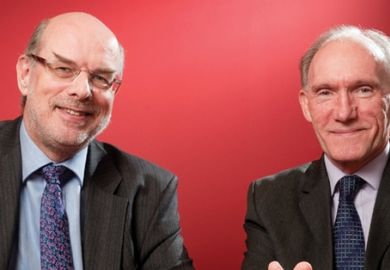The partnership between the universities of Birmingham and Nottingham has produced a £10 million joint centre to research cancer and heart drugs, billed as taking the collaboration “to the next level”.
The Centre of Membrane Proteins and Receptors (COMPARE) will bring together more than 20 leading researchers from both institutions to create more effective drugs with fewer side-effects to treat cardiovascular disease and cancer, while working with the pharmaceutical industry to develop the treatments.
Sir David Eastwood (pictured left, above), the University of Birmingham vice-chancellor, and University of Nottingham counterpart Sir David Greenaway (pictured right, above) spoke to Times Higher Education five years on from the launch of the partnership – which aims to promote collaboration on research, education and professional services, despite the two institutions competing for students.
Greenaway says that the partnership was “a bit directed from the top” when it started, but now there are links between heads of departments and professional services. This is “partly because of spontaneous contact, partly because we bring them [management] together once a year” for a summit, he says. “They drive the new initiatives and new ideas.”
Eastwood highlights the success of the “team we set up to seed research collaboration”, pinpointing professional development, responses to the teaching excellence framework and curricular innovation as other areas where staff will work together.
Birmingham and Nottingham have also partnered in Brazil, where they struck a research cooperation agreement with the São Paulo Research Foundation, Fapesp.
“We’re still active in Brazil,” says Eastwood. “We will think through, probably over the next 12 months, whether there’s another international engagement partnership that we want to seed.”
He adds of the Brazil project: “Putting the two universities together, we had a proposition that was larger than any UK university.”
On COMPARE, Greenaway says that “individually these are both very large institutions. But actually for quite a lot of purposes these days, we’re still not large enough.” There are other externally funded research projects on arthritis and ageing disorders that “probably we wouldn’t be doing if it weren’t for the fact we went in [for funding] together”, he adds.
Eastwood calls COMPARE “a big research initiative, of a kind we haven’t seen between other UK universities funded in this way”. He adds: “In the field [of drug research], we think this is a game changer…For the collaboration, it takes us to a different level.”
The collaboration with its Midlands neighbour has not prevented Birmingham from striking an international research link with the University of Illinois at Urbana-Champaign. Birmingham and Nottingham “did say when we first announced this that we didn’t intend to be monogamous”, says Eastwood.
Since the collaboration launched in 2011, student number controls have been abolished and the two institutions are now in a more fiercely competitive environment. Given the “similar” nature of the two universities and the fact they are in the same region “inevitably quite a number of students putting Birmingham on their application form are also putting Nottingham on their application form”, says Greenaway. “He [Eastwood] wants them, I want them. But that’s the nature of the game.”
Eastwood says of competition on undergraduates and other areas that the collaboration is “not about constraining that process, not about managing that process”, but about recognising there are “areas where we see real benefits in collaboration”.
Register to continue
Why register?
- Registration is free and only takes a moment
- Once registered, you can read 3 articles a month
- Sign up for our newsletter
Subscribe
Or subscribe for unlimited access to:
- Unlimited access to news, views, insights & reviews
- Digital editions
- Digital access to THE’s university and college rankings analysis
Already registered or a current subscriber?





